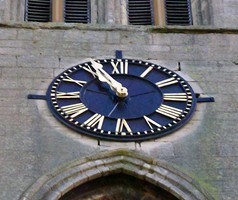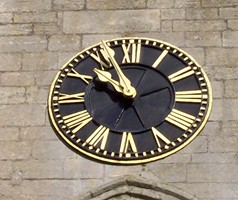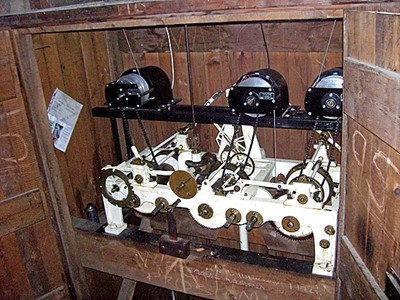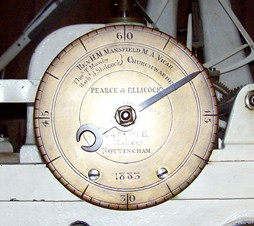|
The church clock INSTALLED 1883
Public clocks date back to the 15th
century, the great clock in the church of the Virgin Mary at Nuremberg
being installed in 1462 while another was erected in Venice in 1497. They
began to appear widely in England during the 18th century and as personal
timepieces were expensive, the public at large depended on them to tell
the time. The Stamford Mercury said on Friday 15th April: "The old church clock of Bourne has recently undergone considerable repair at an expense of £10. The dial has been painted and re-figured and a new minute hand attached. The works also of the clock are expected to have been put into thorough going order. What may have been the effect of the alterations upon the interior parts of the machinery, let the clock itself bear witness in keeping good time but that a great external improvement has been made upon the old one-handed dirty dial is manifest to all." A more colourful report appeared in the Grantham Journal on Saturday 16th April 1859 when credit for the improvement was given to the churchwardens, Thomas Mawby and Robert Mason Mills: "The church clock has undergone thorough alterations and repairs, the dial has been painted, a minute hand has been added, so that now the time of day can be understood, whereas before time was nothing either ornamental or useful; we are not aware of the expense attending this improvement but knowing that the work was not offered for competition, Mr Pearce would not be crippled in his estimate and would therefore be enable to do the work properly and efficiently." The report indicates that the clock only had one face whereas the replacement which was installed in 1883, has two, one on the west side of the tower and the other on the south side. It was fitted following major restoration work of the west end and tower of the Abbey Church which was financed mainly by Robert Mason Mills, a local businessman and devout supporter of the church, and a brass plate was erected in the nave the following year to remember his generosity. The instrument was supplied by a well known Nottingham maker, G and F Cope, and installed by clockmaker Thomas Pearce and Joseph Ellicock, who ran a similar business in West Street, who had installed a new clock in the Town Hall the previous year.
The clock mechanism is located in the
ringers' gallery at the west end of the church and for most of its 190 year history, the clock was wound twice
a week by a team of volunteers which often included the vicar, but since
1983 has been powered electrically. REVISED JULY 2014 Return to The Abbey Church
Go to: Main Index Villages Index
|
||||||||



